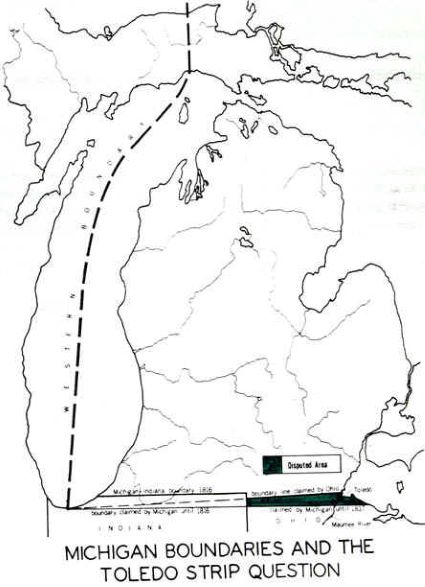Michigan vs. Ohio
I was reminded about the Toledo War between Michigan and Ohio a couple of times this week, and I thought I would recount the story for those unfamiliar with it. It is a story about geography, economics and politics.
One of the reminders was a radio feature about winter recreation in Michigan’s Upper Peninsula. Both dog sledding and ski jumping events are scheduled this week. (As you will soon read, the Upper Peninsula was Michigan’s prize from the Toledo War.)
The other reminder came in my brief research as to the origin of Michigan’s nickname as the Wolverine State. One theory is that the name was given to Michiganders by angry Ohioans during the “War”. Michiganders were described as being as vicious and bloodthirsty as wolverines.
Here is the story:
Ohio’s northern border (or at least the border west of Lake Erie) was set by the Northwest Ordinance of 1787, before Ohio or Michigan became states. This border was established as an east-west line drawn from the southern tip of Lake Michigan.

Why the southern tip of Lake Michigan was chosen for this purpose, I do not know. None of this land had been surveyed yet. The folks who set this line were working with maps like the 1755 map on the left.
It was likely presumed by many that this line included the mouth of the Maumee River (which is now straddled by the City of Toledo, Ohio).
However, as is obvious on a modern map (like the one at the top of the page), the Maumee River meets Lake Erie north (the Michigan side) of the line.
When Ohio became a state in 1803, its constitution altered this line so as to cover the mouth of the Maumee. Congress accepted Ohio’s constitution when Ohio was admitted into the Union.
However, two years later Congress established the Territory of Michigan. The territory’s southern boundary, under this act of Congress, was the old “southern tip of Lake Michigan” line. The line was re-surveyed and Toledo became part of Michigan.
Ohio didn’t accept this result and had the line re-surveyed. The Ohio surveyors concluded (surprise!) that Toledo was in Ohio. Thus for over 30 years, the long strip of land from the Maumee to the Indiana line was claimed by both the State of Ohio and the Territory of Michigan.

The dispute didn’t heat up until settlements grew in northwest Ohio and southeast Michigan. Farmers needed transportation routes to get their crops to market. One of these was the Maumee River, as a route to Lake Erie and, from Lake Erie, to the rest of the world. There was even talk of building a railroad line from Toledo across Michigan to the Kalamazoo River (which flowed into Lake Michigan). With this, Toledo would be the eastern edge of a Lake Michigan – Lake Erie traffic route.
Suddenly, Toledo and the Maumee River became important – maybe even important enough to go to war over.
In the 1830s, Ohio Governor Robert Lucas re-asserted Ohio’s claim over the strip and organized it as an Ohio county. Michigan Territorial Governor Stevens Thompson Mason countered by ordering the arrest of any Ohioan who behaved like an office holder.
Things got almost nasty. Ohio and Michigan both mobilized their militias. Both legislatures appropriated funds to enforce their claims. There were many fights, with acts and counter-acts of vandalism.
There was only one casualty in the war. An officer of the Ohio militia was arrested by a Michigan deputy sheriff. A son of the Ohio militiaman tried to free his father and fought with the deputy. The deputy was wounded with a pen knife and the son fled deep into Ohio.
Politics forced a solution to the boundary dispute. Andrew Jackson was President and an election was coming up. Thus Jackson saw the issue quite plainly: Ohio was a state with a lot of electoral votes (Ohio’s electoral votes were important even then!). Michigan was a territory and did not have any electoral votes. Jackson made certain that the disputed land would be awarded to Ohio.
Jackson’s Attorney General warned him, however, that Michigan had a good case and, indeed, might prevail if the matter were taken to court. [Jackson’s arch-rival, former president John Quincy Adams, said that: “Never in the course of my life have I known a controversy of which all the right was so clearly on one side and all the power so overwhelmingly on the other.”]
Jackson’s solution was to award the strip to Ohio, but award Michigan something else in compensation. The “something else” was the Upper Peninsula, which was then part of the Wisconsin Territory. The deal offered the U.P. to Michigan, and permitted the admission of Michigan into the union, but only if Michigan gave up its claim to Toledo.
The Michigan legislature said NO. It didn’t make sense to them at the time to trade Toledo for the Upper Peninsula.
Clearly Jackson had to sweeten the pot, and the sweetener was $400,000.
The United States Treasury had a surplus at the time and the plan was to distribute the surplus to the states. Michigan would get its share ($400,000) if it were a state and would get zero if it were still a territory.

Michigan chose to accept the deal. The state waived its claim to the Ohio strip and Congress included the Upper Peninsula in Michigan’s grant of statehood. Michigan became a state in January of 1837, just in time to collect its share of the federal surplus!
[For this and other stories in Michigan history, see Michigan A History by Bruce Catton. Also, for summaries of the Toledo War, see this Michigan.gov site and this Michigan State University site.
